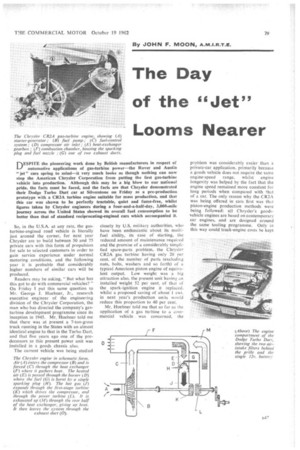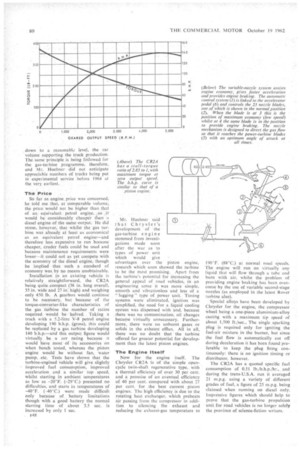The Day of the "Jet" Looms Nearer
Page 81

Page 82

If you've noticed an error in this article please click here to report it so we can fix it.
DESPITE the pioneering work done by British manufacturers in respect of automotive applications of gas-turbine power—the Rover and Austin "jet" cars spring to mind—it very much looks as though nothing can now stop the American Chrysler Corporation from putting the first gas-turbine vehicle into production. Although this may be a big blow to our national pride, the facts must be faced, and the facts are that Chrysler demonstrated their Dodge Turbo Dart car at Silverstone on Friday as a pre-production prototype with a CR2A turbine engine suitable for mass production, and that this car was shown to be perfectly tractable, quiet and fume-free, whilst figures taken by Chrysler engineers during a four-and-a-half-day, 3,000-mile journey across the United States showed its overall fuel consumption to be better than that of standard reciprocating-engined cars which accompanied it
So, in the USA. at any rate, the gas-. turbine-engined road vehicle is literally just around the corner, for next year Chrysler are to build between 50 and 75 private cars with this form of propulsion for sale to selected customers in order to gain service experience under normal motoring conditions, and the following year it is probable that considerably higher numbers of similar cars will be produced.
Readers may be asking, "nut what has this got to do with commercial vehicles?" On Friday I put this same question to Mr. George J. Huebner, Jr., research executive engineer of the engineering division of the Chrysler Corporation, the man who has directed the company's gasturbine development programme since its inception in 1945. Mr, Huebner told me that there was at present a 7-ton-gross truck running in the States with an almost identical engine to that in the Turbo Dart, and that five years ago one of the predecessors to this present power unit was installed in a goods chassis also.
The current vehicle was being studied closely. by U.S, military authorities, who have been enthusiastic about its multifuel ability, its ease of starting, the reduced amount of maintenance required and the promise of a considerably simplified spare-parts problem, the Chrysler CR2A gas turbine having only 20 per cent, of the number of parts (excluding nuts, bolts, washers and so forth) of a typical American piston engine of equivalent output. Low weight was a big attraction also, the present unit having an installed weight 52 per cent. of that of the spark-ignition engine it replaced, whilst a proposed saving of about 1 cwt. in next year's production units would reduce this proportion to 40 per cent.
Mr. Huebner told me that so far as the application of a gas turbine to a commercial vehicle was concerned, the
problem was considerably easier than a private-car application, primarily because a goods vehicle does not require the same engine-speed range, whilst engine longevity was helped by the fact that the engine speed remained more constant for long periods when compared with that of a car. The only reason why the CR2A Was being offered in cars first was that piston-engine production methods were being followed: all Chrysler's goodsvehicle engines are based on contemporary car engines, and are designed around the same tooling programme. Only in this way could truck-engine costs he kept
down to a reasonablo level, the car volume supporting the truck production. The same principle is being followed for the gas-turbine programme, therefore, and Mr. Huebner did not anticipate appreciable numbers of trucks being put in experimental service before 1964 at the very earliest.
The Price
So far as engine price was concerned; he told one that, at -comparable volume; the pricewould not be higher than that of an equivalent . petrol engine, ,so it would be considerably cheaper than a diesel. engine of the same output. He did stress,however; that -whilst the gas turbine was already at least as economical as an equivalent petrol engine—and therefore less expensive to run because cheaper, cruder fuels could be used and because maintenance requirements were lower—it could not as yet compete with the economy of the diesel engine, though he implied that such a standard of economy was by no means unobtainable.
Installation' in an existing vehicle is relatively straightforward, the CR2A being quite.compact (36 in. long overall, 35 in. wide and 27 in high) and weighing only 450 lb. A gearbox would continue to be neceSsary, but because of the torque-converter-like characteristics of the gas turbine the number of ratios required would be halved. Taking a truck. with a 5.2-litre y-8 petrol engine developing 190 b.h.p. (gross), this could be replaced by a gas turbine developing 140 b.h.p.—and this output figure would virtually be a net rating because it would have most of its accessories on when bench tested, whereas the piston engine would be without fan, water pump. _etc. Tests have shown that the turbine-engined Vehicle will give slightly improved fuel consumption, improved acceleration and a similar top speed, whilst starting in ambient temperatures as low as –20°F. (-29°C.) presented no difficulties, and starts in temperatures of –40°F. (-40°C.) were made difficult only because of battery limitations though with a good battery the normal starting time of about 3.5 sec. is increased by only 1 sec.
e48 Mr. Huebner said that Chrysler's development of the gas-turbine engine stemmed from investigations made soon after the war as to types of power unit which would give — advantages over the piston engine, research which soon showed the turbine to be the most promising. Apart from the turbine's potential for increasing the general appeal of road vehicles, in . an engineering sense it was more simple, smoothand vibrationless and less of a lugging" type of power unit. Timing systems were eliminated, ignition was simplified, the need for a liquid cooling system was dispensed with and, because . there was no contamination, oil changes became virtually unnecessary. Furthermore, there were no unburnt gases or solids in the exhaust efflux. All in all, there was no doubt that the turbine offered far greater potential for development than the latest piston engines.
The Engine Itself Now for the engine itself. The Chrysler CR2A is of the simple opencycle twin-shaft regenerative type, . with a thermal efficiency of over 30 per cent. and a promise of an eventual efficiency of 40 per cent. compared with about 27 per cent, for the best current .piston engines. The high efficiency is due to the rotating heat exchanger, which preheats air passing from the compressor in addition to silencing the exhaust and reducing the exhaust-gas temperature to
190°F. (88°C.) at normal road speeds. The •engine will run on virtually any liquid that will flow through a tube and burn with air, whilst the problem of providing engine braking has been overcome by the use of variable second-stage nozzles (as. employed in the latest Rover turbine also).
Special alloys have been developed by Chrysler for the engine, the compressor wheel being a one-piece aluminium-alloy casting with a maximum tip speed of about 1,500 ft./sec.. The single sparking plug is required only for igniting the fuel-air mixture in the burner, but since the fuel flow is automatically cut off during deceleration it has been found preferable to keep the plug firing continuously: there is no ignition timing or distributor, however.
The CR2A has a quoted specific fuel consumption of 0.51 lb./b.h.p./hr., and dnring the trans-U.S.A. run it averaged 21 m.p.g. using a variety of different grades of fuel, a figure of 25 m.p.g. being claimed when running on diesel only. Impressive figures which should help to prove that the gas-turbine propulsion unit for road vehicles is no longer solely the province of science-fiction writers.




































































































































